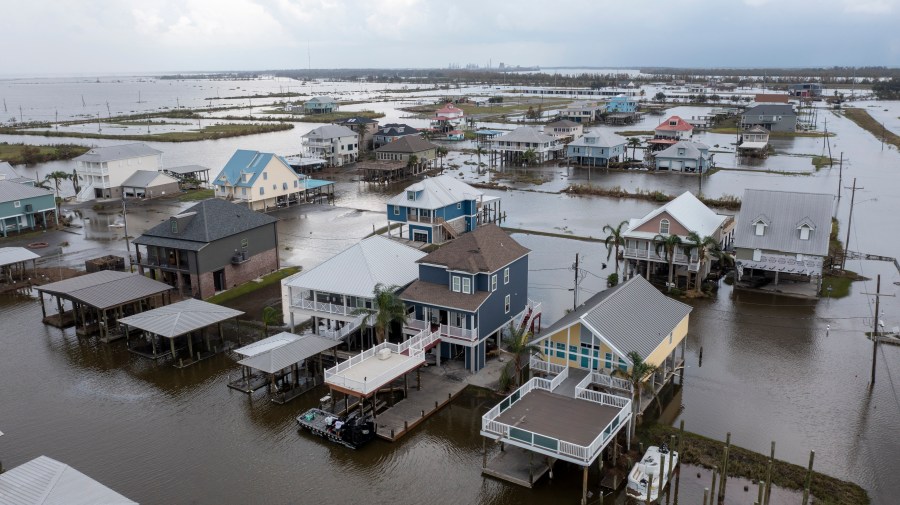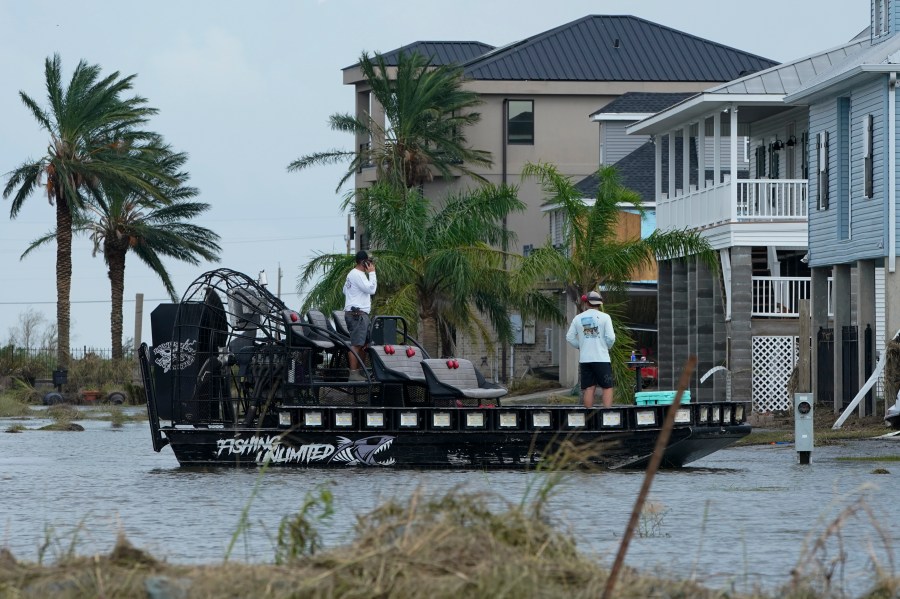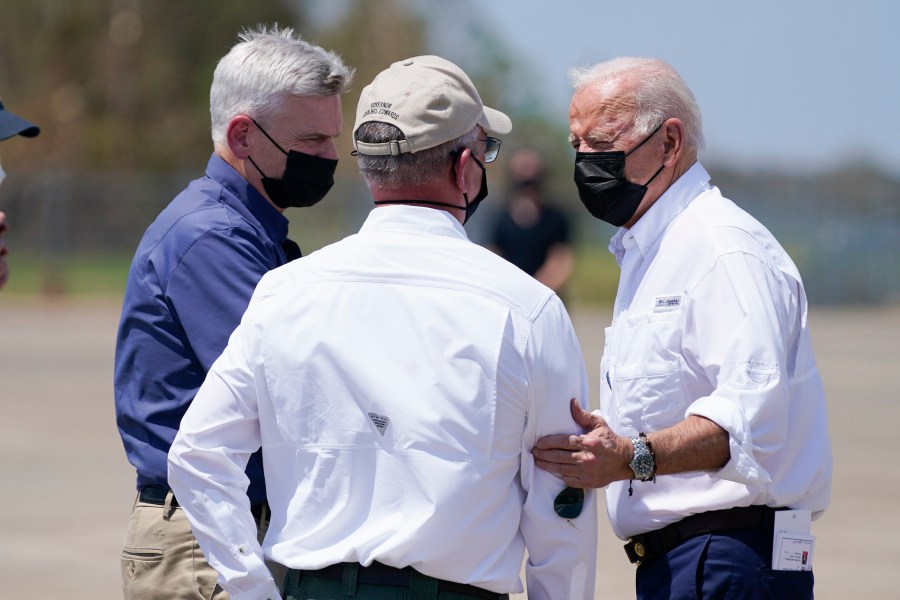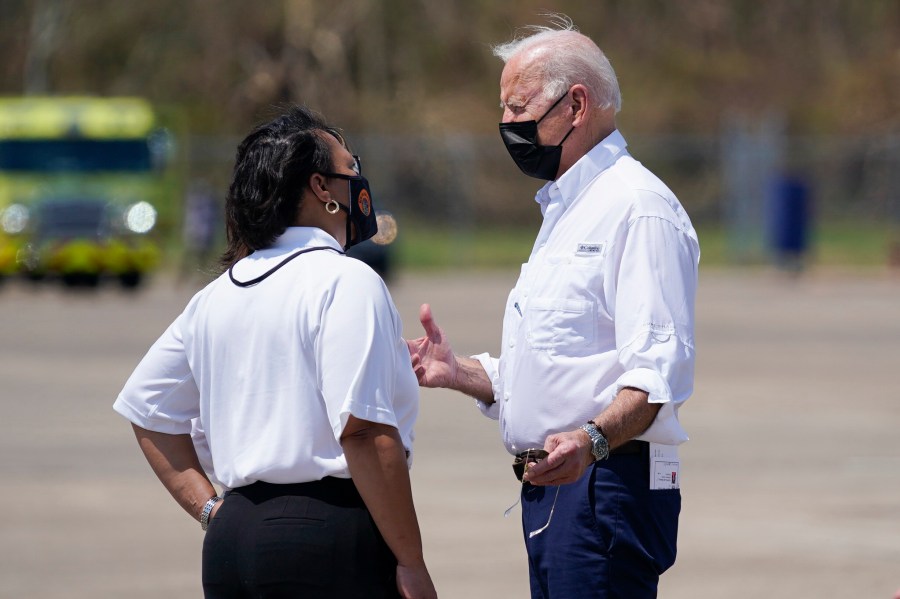‘We are here for you’: Biden in New Orleans to see Ida damage, pledges federal help

President Joe Biden greets Louisiana Gov. John Bel Edwards as he arrives at Louis Armstrong New Orleans International Airport in Kenner, La., Friday, Sept. 3, 2021, to tour damage caused by Hurricane Ida. Watching from left are Jefferson Parish President Cynthia Lee Sheng, New Orleans Mayor LaToya Cantrell, Rep. Steve Scalise, R-La., Sen. John Kennedy, R-La., and Sen. Bill Cassidy, R-La. (AP Photo/Evan Vucci)
NEW ORLEANS (AP) — President Joe Biden got his first glimpse of the destruction wrought by Hurricane Ida even before he landed in Louisiana on Friday, with blue tarps covering shredded roofs of houses and uprooted trees visible as Air Force One approached New Orleans.
In advance of his trip, the president called for greater public resolve to confront climate change and help the nation deal with the fierce storms, flooding and wildfires that have beset the country.
Biden, in rolled-up shirtsleeves and boots, was welcomed at the airport by Louisiana Gov. John Bel Edwards, who said Thursday that there’s no substitute “for actually being on the ground, speaking with the local officials and seeing with your own eyes the utter devastation that the state of Louisiana has sustained because of Hurricane Ida.”
Edwards said he would give the president a “long list” of requests for federal assistance.
Biden was scheduled to meet with local officials and tour a neighborhood in LaPlace, a community between the Mississippi River and Lake Pontchartrain that suffered catastrophic wind and water damage and was left with sheared-off roofs and flooded homes. He also planned a flyover tour of hard-hit communities including Lafitte, Grand Isle, Port Fourchon and Lafourche Parish, where Parish President Archie Chaisson said 25% of the homes in his community of 100,000 people were gone or had catastrophic damage.
Trips to natural disaster scenes have long been a feature of the U.S. presidency. It’s a moment to show compassion and deliver aid in ways that can shape the public’s perception of White House leadership.
Past presidents have been defined in part by how they handled such crises. Donald Trump casually lobbed paper towels to people in Puerto Rico after a hurricane, generating scorn from critics but little damage to his political standing. Barack Obama hugged New Jersey Republican Gov. Chris Christie in 2012 after Superstorm Sandy, a brief respite from partisan tensions that had threatened the economy. And George W. Bush fell out of public favor after a poor and unprepared response to Hurricane Katrina, which swamped New Orleans in 2006.
In the aftermath of Hurricane Ida, Biden is grappling with the persistent threat posed by climate change and the prospect that disaster zone visits may become a more regular feature of the presidency.
When Biden last visited Louisiana in May, to promote his infrastructure package, he spoke in the city of Lake Charles, where there was a glass tower visible from the podium that was still covered in plywood because a pair of hurricanes last year had blown out the windows.
Scientists say climate change increases the frequency of extreme weather events — such as large tropical storms and the droughts and heatwaves that create conditions for vast wildfires. U.S. weather officials recently reported that July 2021 was the hottest month ever recorded in 142 years of record-keeping.
As for Friday’s trip, Biden said his message to the Gulf Coast was: “We are here for you. And we’re making sure the response and recovery is equitable so that those hit hardest get the resources they need and are not left behind.”
Biden’s nearly eight-month-old presidency has been shaped in part by perpetual crises. The president went to Texas in February after a cold winter storm caused its power grid to fail and he has repeatedly monitored the wildfires that have darkened skies in Western states.
Besides natural disasters, the president has had to contend with a multitude of other challenges. He is searching for ways to rescue the 100-200 Americans stuck in Afghanistan after the longest war in U.S. history ended only a matter of days ago. He is also confronting the delta variant of the coronavirus that has struck the country in an autumn of uncertainty only months after Biden declared independence from the disease at a July 4 celebration on the White House lawn.
His call for resolve to help the country overcome the pandemic and forge a $1 trillion infrastructure deal is now being applied to the perilous task of withstanding the aftershocks of climate change.
“The past few days of Hurricane Ida and the wildfires in the West and the unprecedented flash floods in New York and New Jersey is yet another reminder that these extreme storms and the climate crisis are here,” he said Thursday. “We need to be much better prepared. We need to act.”
Biden pledged robust federal help for states dealing with natural disasters. And he said he will further press Congress to pass his nearly $1 trillion infrastructure bill to improve roads, bridges, the electric grid and sewer systems. The proposal intends to ensure that the vital networks connecting cities and states and the country as a whole can withstand the flooding, whirlwinds and damage caused by increasingly dangerous weather.
Ida was the fifth-most powerful storm to strike the U.S. when it hit Louisiana on Sunday with maximum winds of 150 mph, likely causing tens of billions of dollars in flood, wind and other damage, including to the electrical grid. On Wednesday, the storm’s remnants dropped devastating rainfall across parts of Maryland, Pennsylvania, New York and New Jersey, causing significant disruption to major population centers.
The storm has killed at least 49 people in the Northeastern U.S. and at least 13 in Louisiana, Mississippi and Alabama.
















